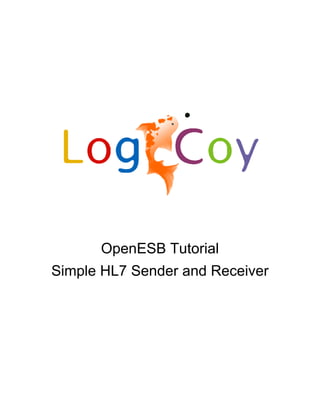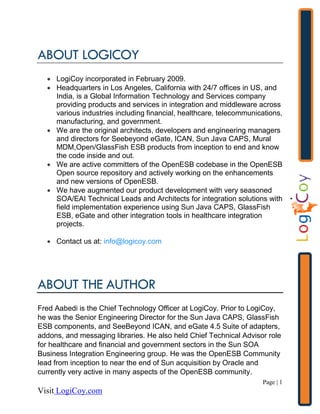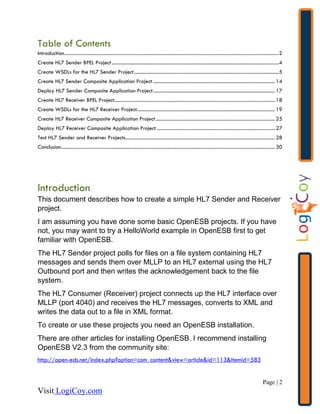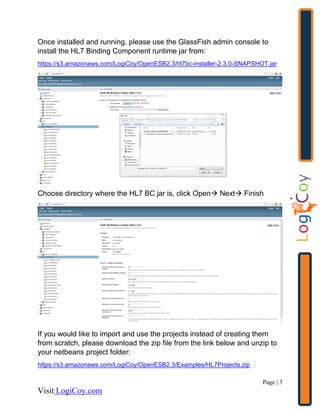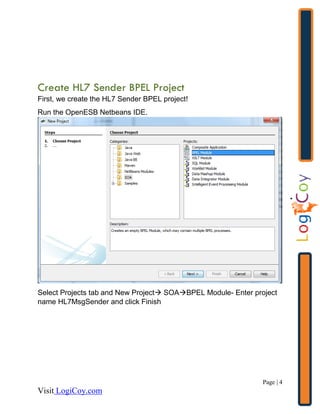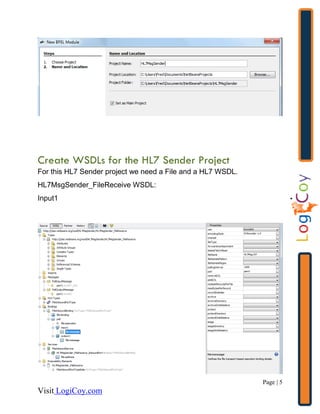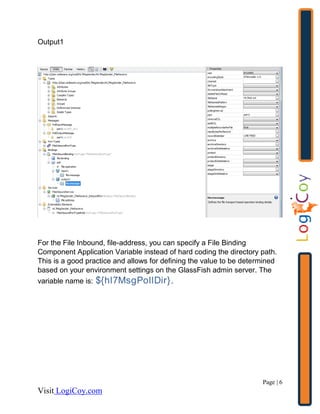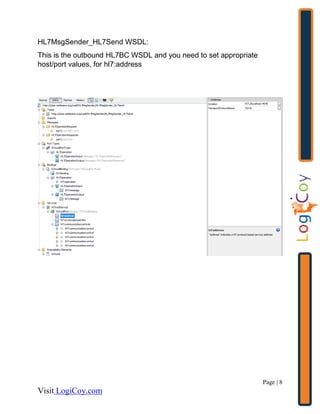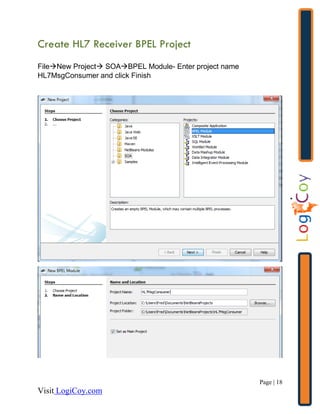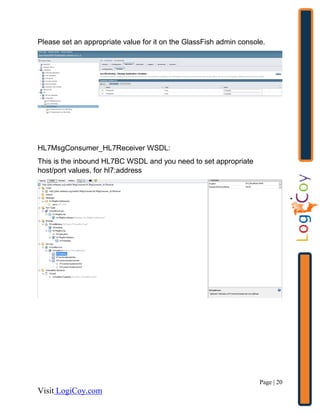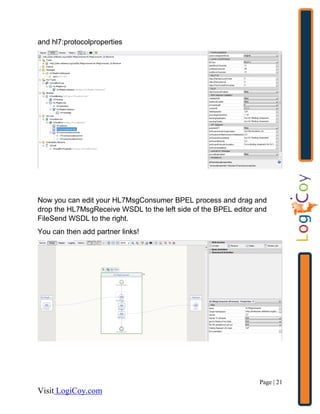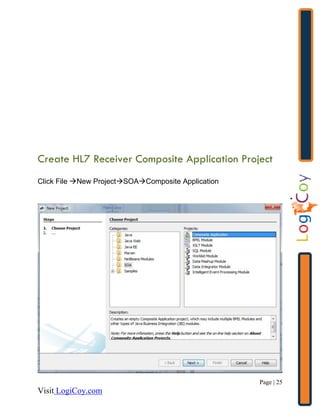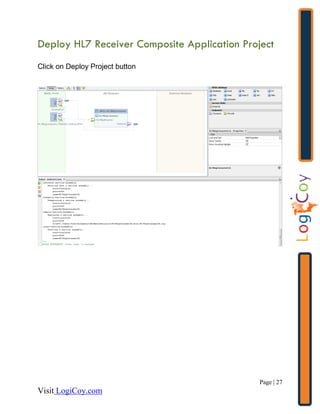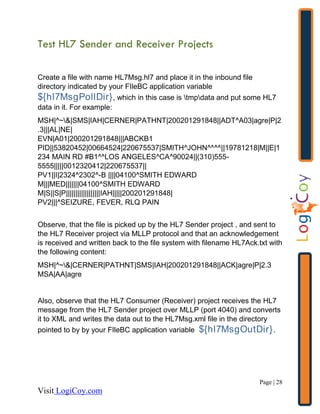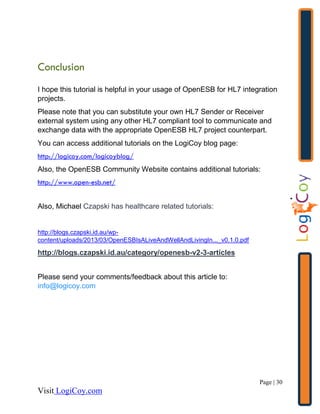LogiCoy OpenESB HL7 Example
- 1. OpenESB Tutorial Simple HL7 Sender and Receiver
- 2. Page | 1 Visit LogiCoy.com ABOUT LOGICOY ’éĘ LogiCoy incorporated in February 2009. ’éĘ Headquarters in Los Angeles, California with 24/7 offices in US, and India, is a Global Information Technology and Services company providing products and services in integration and middleware across various industries including financial, healthcare, telecommunications, manufacturing, and government. ’éĘ We are the original architects, developers and engineering managers and directors for Seebeyond eGate, ICAN, Sun Java CAPS, Mural MDM,Open/GlassFish ESB products from inception to end and know the code inside and out. ’éĘ We are active committers of the OpenESB codebase in the OpenESB Open source repository and actively working on the enhancements and new versions of OpenESB. ’éĘ We have augmented our product development with very seasoned SOA/EAI Technical Leads and Architects for integration solutions with field implementation experience using Sun Java CAPS, GlassFish ESB, eGate and other integration tools in healthcare integration projects. ’éĘ Contact us at: info@logicoy.com ABOUT THE AUTHOR Fred Aabedi is the Chief Technology Officer at LogiCoy. Prior to LogiCoy, he was the Senior Engineering Director for the Sun Java CAPS, GlassFish ESB components, and SeeBeyond ICAN, and eGate 4.5 Suite of adapters, addons, and messaging libraries. He also held Chief Technical Advisor role for healthcare and financial and government sectors in the Sun SOA Business Integration Engineering group. He was the OpenESB Community lead from inception to near the end of Sun acquisition by Oracle and currently very active in many aspects of the OpenESB community.
- 3. Page | 2 Visit LogiCoy.com Table of Contents Introduction ........................................................................................................................................................................... 2 Create HL7 Sender BPEL Project ..................................................................................................................................... 4 Create WSDLs for the HL7 Sender Project ................................................................................................................... 5 Create HL7 Sender Composite Application Project ................................................................................................. 14 Deploy HL7 Sender Composite Application Project ................................................................................................. 17 Create HL7 Receiver BPEL Project................................................................................................................................ 18 Create WSDLs for the HL7 Receiver Project.............................................................................................................. 19 Create HL7 Receiver Composite Application Project ............................................................................................... 25 Deploy HL7 Receiver Composite Application Project .............................................................................................. 27 Test HL7 Sender and Receiver Projects ....................................................................................................................... 28 Conclusion .......................................................................................................................................................................... 30 Introduction This document describes how to create a simple HL7 Sender and Receiver project. I am assuming you have done some basic OpenESB projects. If you have not, you may want to try a HelloWorld example in OpenESB first to get familiar with OpenESB. The HL7 Sender project polls for files on a file system containing HL7 messages and sends them over MLLP to an HL7 external using the HL7 Outbound port and then writes the acknowledgement back to the file system. The HL7 Consumer (Receiver) project connects up the HL7 interface over MLLP (port 4040) and receives the HL7 messages, converts to XML and writes the data out to a file in XML format. To create or use these projects you need an OpenESB installation. There are other articles for installing OpenESB. I recommend installing OpenESB V2.3 from the community site: http://open-esb.net/index.php?option=com_content&view=article&id=113&Itemid=583
- 4. Page | 3 Visit LogiCoy.com Once installed and running, please use the GlassFish admin console to install the HL7 Binding Component runtime jar from: https://s3.amazonaws.com/LogiCoy/OpenESB2.3/hl7bc-installer-2.3.0-SNAPSHOT.jar Choose directory where the HL7 BC jar is, click Open’āĀ Next’āĀ Finish If you would like to import and use the projects instead of creating them from scratch, please download the zip file from the link below and unzip to your netbeans project folder: https://s3.amazonaws.com/LogiCoy/OpenESB2.3/Examples/HL7Projects.zip
- 5. Page | 4 Visit LogiCoy.com Create HL7 Sender BPEL Project First, we create the HL7 Sender BPEL project! Run the OpenESB Netbeans IDE. Select Projects tab and New Project’āĀ SOA’āĀBPEL Module- Enter project name HL7MsgSender and click Finish
- 6. Page | 5 Visit LogiCoy.com Create WSDLs for the HL7 Sender Project For this HL7 Sender project we need a File and a HL7 WSDL. HL7MsgSender_FileReceive WSDL: Input1
- 7. Page | 6 Visit LogiCoy.com Output1 For the File Inbound, file-address, you can specify a File Binding Component Application Variable instead of hard coding the directory path. This is a good practice and allows for defining the value to be determined based on your environment settings on the GlassFish admin server. The variable name is: ${hl7MsgPollDir}.
- 8. Page | 7 Visit LogiCoy.com Please set an appropriate value for it on the GlassFish admin console.
- 9. Page | 8 Visit LogiCoy.com HL7MsgSender_HL7Send WSDL: This is the outbound HL7BC WSDL and you need to set appropriate host/port values, for hl7:address
- 10. Page | 9 Visit LogiCoy.com and hl7:protocolproperties
- 11. Page | 10 Visit LogiCoy.com Now you can edit your HL7MsgSender BPEL process and drag and drop the FileReceive WSDL to the left side of the BPEL editor and HL7Sender WSDL to the right. You can then add partner links!
- 12. Page | 11 Visit LogiCoy.com
- 13. Page | 12 Visit LogiCoy.com Assign1 activity HL7Invoke
- 14. Page | 13 Visit LogiCoy.com Assign2 HL7AckReply
- 15. Page | 14 Visit LogiCoy.com Create HL7 Sender Composite Application Project Click File ’āĀNew Project’āĀSOA’āĀComposite Application
- 16. Page | 15 Visit LogiCoy.com Project name: HL7MsgSenderCA Click Finish.
- 17. Page | 16 Visit LogiCoy.com Add the BPEL module HL7MsgSender and click Build Project.
- 18. Page | 17 Visit LogiCoy.com Deploy HL7 Sender Composite Application Project Click on Deploy Project button
- 19. Page | 18 Visit LogiCoy.com Create HL7 Receiver BPEL Project File’āĀNew Project’āĀ SOA’āĀBPEL Module- Enter project name HL7MsgConsumer and click Finish
- 20. Page | 19 Visit LogiCoy.com Create WSDLs for the HL7 Receiver Project For this HL7 Receiver project we need a File and a HL7 WSDL. HL7MsgConsumer_FileSend WSDL: FileOutboundBinding - Input1 Output filename: HL7Msg.xml For the File Outbound, file-address, you can specify a File Binding Component Application Variable instead of hard coding the directory path. This is a good practice and allows for defining the value to be determined based on your environment settings on the GlassFish admin server. The variable name is: ${hl7MsgOutDir}.
- 21. Page | 20 Visit LogiCoy.com Please set an appropriate value for it on the GlassFish admin console. HL7MsgConsumer_HL7Receiver WSDL: This is the inbound HL7BC WSDL and you need to set appropriate host/port values, for hl7:address
- 22. Page | 21 Visit LogiCoy.com and hl7:protocolproperties Now you can edit your HL7MsgConsumer BPEL process and drag and drop the HL7MsgReceive WSDL to the left side of the BPEL editor and FileSend WSDL to the right. You can then add partner links!
- 23. Page | 22 Visit LogiCoy.com Assign1 activity
- 24. Page | 23 Visit LogiCoy.com FIleSend- Write operation
- 25. Page | 24 Visit LogiCoy.com
- 26. Page | 25 Visit LogiCoy.com Create HL7 Receiver Composite Application Project Click File ’āĀNew Project’āĀSOA’āĀComposite Application
- 27. Page | 26 Visit LogiCoy.com Project name: L7MsgConsumerCA Click Finish. Add the BPEL module HL7MsgConsumer and click Build Project.
- 28. Page | 27 Visit LogiCoy.com Deploy HL7 Receiver Composite Application Project Click on Deploy Project button
- 29. Page | 28 Visit LogiCoy.com Test HL7 Sender and Receiver Projects Create a file with name HL7Msg.hl7 and place it in the inbound file directory indicated by your FIleBC application variable ${hl7MsgPollDir}, which in this case is tmpdata and put some HL7 data in it. For example: MSH|^~&|SMS|IAH|CERNER|PATHNT|200201291848||ADT^A03|agre|P|2.3|||AL|NE| EVN|A01|200201291848|||ABCKB1 PID||53820452|00664524|220675537|SMITH^JOHN^^^^||19781218|M||E|1234 MAIN RD #B1^^LOS ANGELES^CA^90024||(310)555- 5555|||||0012320412|220675537|| PV1||I|2324^2302^-B ||||04100^SMITH EDWARD M|||MED|||||||04100^SMITH EDWARD M|S||S|P||||||||||||||||||IAH|||||200201291848| PV2|||^SEIZURE, FEVER, RLQ PAIN Observe, that the file is picked up by the HL7 Sender project , and sent to the HL7 Receiver project via MLLP protocol and that an acknowledgement is received and written back to the file system with filename HL7Ack.txt with the following content: MSH|^~&|CERNER|PATHNT|SMS|IAH|200201291848||ACK|agre|P|2.3 MSA|AA|agre Also, observe that the HL7 Consumer (Receiver) project receives the HL7 message from the HL7 Sender project over MLLP (port 4040) and converts it to XML and writes the data out to the HL7Msg.xml file in the directory pointed to by by your FIleBC application variable ${hl7MsgOutDir}.
- 30. Page | 29 Visit LogiCoy.com The contents look should like this:
- 31. Page | 30 Visit LogiCoy.com Conclusion I hope this tutorial is helpful in your usage of OpenESB for HL7 integration projects. Please note that you can substitute your own HL7 Sender or Receiver external system using any other HL7 compliant tool to communicate and exchange data with the appropriate OpenESB HL7 project counterpart. You can access additional tutorials on the LogiCoy blog page: http://logicoy.com/logicoyblog/ Also, the OpenESB Community Website contains additional tutorials: http://www.open-esb.net/ Also, Michael Czapski has healthcare related tutorials: http://blogs.czapski.id.au/wp- content/uploads/2013/03/OpenESBIsALiveAndWellAndLivingIn..._v0.1.0.pdf http://blogs.czapski.id.au/category/openesb-v2-3-articles Please send your comments/feedback about this article to: info@logicoy.com

